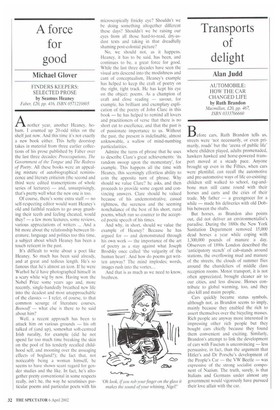Transports of delight
Alan Judd
AUTOMOBILE: HOW THE CAR CHANGED LIFE by Ruth Brandon
Macmillan, £20, pp. 467, ISBN 0333766660
Before cars, Ruth Brandon tells us, streets were 'not necessarily, or even primarily, roads' but the 'arena of public life' where children played, adults promenaded, hawkers hawked and horse-powered transport moved at a steady pace. Anyone brought up even in the Fifties, when cars were plentiful, can recall the automotive and pre-automotive ways of life co-existing: children still walked to school, rag-andbone men still came round with their horses and carts and the cries of their trade. My father — a greengrocer for a while — made his deliveries with old Dobbin between the shafts.
But horses, as Brandon also points out, did not deliver an environmentalist's paradise. During the 1880s the New York Sanitation Department removed 15,000 dead horses a year while coping with 1,300,000 pounds of manure a day. Observers of 1890s London described the 'anticipatory stench' of cab-stands around stations, the overflowing mud and manure of the streets, the clouds of summer flies around the chandeliers of middle class reception rooms. Motor transport, it is not often appreciated, brought cleaner air to our cities, and less disease. Horses contribute to global warming, too, and they also kill and maim people.
Cars quickly became status symbols, although not, as Brandon seems to imply, mainly because they enabled the rich to assert themselves over the bicycling masses. Rich people are anyway more interested in impressing other rich people but they bought cars chiefly because they found them convenient and exciting. Similarly, Brandon's attempt to link the development of cars with Fascism is unconvincing — less persuasive, in fact, than the argument that Hitler's and Dr Porsche's development of the People's Car — the VW Beetle — was expressive of the strong socialist component of Nazism. The truth, surely, is that Italians and Germans under almost any government would vigorously have pursued their love affair with the car. Brandon's style is often glibly conversational and some of her paragraphs read like the introduction to a contemporary dictionary of received opinion:
Through the automotive prism a new light falls upon the great questions of our age — class war, alienation, the destruction of the countryside, the influence of big business on politics, feminism, the power of fantasy, the death of the environment.
But there are compensations. Her discursive approach throws up memorable details — such as that ladies in late 19th-century America 'were in the habit of bringing all their jewels to dinner parties and laying those they couldn't wear beside their plates'. Or that Jayne Mansfield was decapitated when she stuck her head out of her car window, or that the offence of dangerous driving was introduced in 1956 because juries wouldn't convict drivers of manslaughter, or that in 1996 it cost an estimated £52 per week to keep a car on the road and in 2000 £72. Perhaps inevitably, there's also a sprinkling of canards, partial quotes and misquotes — we read yet again that MI5 might have killed Princess Diana, and that Mrs Thatcher really believed there was 'no such thing as society'.
However, there's also meatier stuff. Brandon's assessment of Prince Charles's Poundbury village project in Dorset — theoretically almost car-free but in fact an 'automobile suburb' — is thoughtful and fair. Her account of the evolution of the production line, its influence on labour, skills and housing, is good, and her summary of the technology that could lead to 'autopilot' driving is interesting. In assessing the influence of the car — or lack of car — on town planning, she provides a good short study of Letchworth, Hertfordshire, while her accounts of Henry Ford and John Delorean are revealing. We might have had a full chapter on cars and crime — not only car crime but the car's role in making the criminal mobile, as witnessed by many Home Counties householders when the M25 was opened nearby.
Unsurprisingly, her final chapter — on likely future developments — is in some ways the meatiest because the issues are current and difficult. She gives an informed summary of new fuel technologies, and wisely doesn't put all her money on any of them. With the caveat that previous forecasts about fossil fuel reserves have always proved pessimistic, it looks to me as though our mid-term driving future will involve a combination of biodiesel or equivalent (meaning we'll grow our fuel) and hydrogen fuel cells.
The book ends with more questions than answers, but that's fair enough. One thing we can be sure of: now that the genie of unlimited independent movement is out of the bottle, we ain't about to give it up. The social history of the automobile doesn't end here.































































 Previous page
Previous page